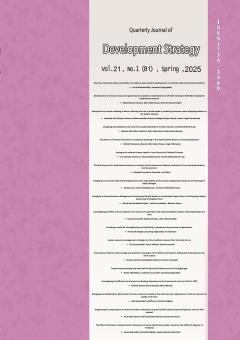بررسی کارایی بانکداری بدون ربا در استان¬های ایران از سال 1391 تا 1399
الموضوعات : Economic
قاسم رضایی
1
,
حمید آسایش
2
![]() ,
رضا معبودی
3
,
رضا معبودی
3
![]()
1 - دانشجوی دکتری اقتصاد ، گروه اقتصاد، دانشکده اقتصاد ، دانشگاه آزاد اسلامی واحد الیگودرز ، الیگودرز ، ایران
2 - دانشیار ، گروه اقتصاد، دانشکده علوم انسانی، دانشگاه آیت الله بروجردی،بروجرد ،ایران.
3 - عضو هیات علمی گروه اقتصاد، دانشکده علوم انسانی، دانشگاه آیت اله العظمی بروجردی.
الکلمات المفتاحية: کارایی, تحلیل مرزی تصادفی, بانکداری بدون ربا.,
ملخص المقالة :
هدف پژوهش حاضر بررسی روند کارایی استانی سیستم بانکی بدون ربا و تحلیل عوامل موثر بر آن است. برای بررسی کارایی بانک¬ها و سیستم بانکداری در استان¬ها از دو دسته متغیر شرایط اقتصادی و متغیرهای کلان(تولید ناخالص داخلی استانی و نرخ تورم استانی) و متغیرهای مربوط به عملکرد بانک¬ها (سپرده¬های بانکی، مطالبات غیرجاری در استان، تعداد شعب در استان، تعداد کارکنان بانکی) در سطح استان¬های کشور طی سال های 1391 الی 1399 استفاده شد. همچنین، برای تجزیه و تحلیل روابط بین متغیرها از روش تحلیل مرزی تصادفی و مدل بیتس کویلی بهره گرفته شد. یافته¬ها نشان دادند میزان کارایی بان¬ها در طی دوره مورد مطالعه به تدریج و به میزان اندکی، کاهش یافته است. در بین متغیرهای بررسی شده، رشد اقتصادی بر میزان کارایی بانک¬ها اثر مثبت دارد؛ بنابراین افزایش درآمد در هر استان میزان تقاضا برای تسهیلات و همچنین منابع لازم برای سپرده¬گذاری در بانک¬هارا فراهم می¬آورد. همچنین، افزایش میزان تسهیلات غیرجاری موجب کاهش کارایی بانک¬ها در سطح استان¬ها می¬شود. با توجه نتایج پژوهش، دولت از طریق ابزارهایی مانند معافیت¬های مالیاتی، از طریق حمایت از صنایع، افزایش درآمد سرانه و بالتبع افزایش منابع بانک¬ها و کاهش مطالبات غیرجاری آن ها را فراهم نماید.
منابع:
[1] Amiri, hossein. Evaluation the Effectiveness of Selected Banks in Iran and its Relationship with Banking Internal and Macroeconomic Variables. Journal of Applied Economics Studies, iran, 7(6), 2018 ,89-114 [in persian]
[2] Hosseini, Seyed Shamsuddin., Rakhshan, Seyed Ali. Investigating the efficiency, productivity and ranking of selected banks of the Islamic Republic of Iran using data envelopment analysis method. Defense Economics Quarterly, Fourth 4(12),2019 [in persian]
[3] Asayesh, h, hosseini nasab., s.e, sahabi, b. comparing technical efficiency in Iranian public and private banks with SFA in 2006-2009. International of review in life sciences, 5(7),2015
[4] Panahian, Hosein. THE EFFECTS OF RISK ON THE EFFICIENCY OF IRANIAN BANKS BASED ON DEA METHOD. Accounting and Auditing Research,4(17),2013 [in persian]
[5] Lee J, Y., Kim, D. Bank performance and its determinants in Korea. Japan and the World Economy 27,2014, 83-94
[6] Fujii, H., Managi, S., Matousek R. Indian bank efficiency and productivity changes with undesirable outputs: A disaggregated approach. Journal of Banking & Finance, 38,2014, 41–50
[7] Sarmiento1, M., Galán, J. E. Heterogeneous Effects of Risk-Taking on Bank Efficiency: A Stochastic Frontier Model with Random Coefficients. Statistics and Econometrics Series (13), Working Paper,2014, 14-20.
[8] Kao, C. Liu S Multi-period efficiency measurement in data.2014
[9] Elisa Luciano and Luca Regis. Bank Efficiency and Banking Sector Development the case of Italy. Applied Mathematics, Working Paper Series, Working Paper No. 5/2017
[10] Panahian, Hosein., Abyak, Hassan. THE EFFECTS OF RISK ON THE EFFICIENCY OF IRANIAN BANKS BASED ON DEA METHOD. Journal of accounting and auditing research,5(17),2013,68-85 [in persian
[11] Ranjbar, Mansour., Becky Haskooi, Mrenzi., Farahanifard, Saeed. Investigating the factors affecting the technical efficiency of the Iranian banking system using a combined data approach. Econometric Modeling Quarterly,1(2),2014 [in persian]
[12] Shahraki, Javad, Shahiki Tash, Mohammadi Nabi., Khajeh Hassani, Mustafa Evaluating the efficiency of the Iranian banking system using the Bootstrap envelopment analysis approach and the SW algorithm. Monetary-Banking Research Quarterly, 9(28),2016 [in persian]
[13] Memarpour, Mehdi., Waezi, Ehsan. Evaluate the efficiency and ranking of a private bank's branches using a two-stage coverage analysis approach and the Barda ranking technique. Journal of Decision Making and Operations Research, 2(2) 2017 [in persian]
[14] Seyed Noorani, Seyed Mohammad Reza., Shakeri, Abbas., Khadem Alizadeh., Amir, Vafaie., Yeganeh, Reza Measuring the productivity indicators of selected banks in the interest-free banking system of the Islamic Republic of Iran (with emphasis on efficiency and effectiveness). Economic Research Journal ,18(70),2018 [in persian]
[15] Dehghani, Mohammad Ali. Structure and performance of Iran's banking industry. Tarbiat Modares University, PhD Thesis in Economics,2011 [in persian]
[16] Amir Yousefi, K., Hafezi, B. Efficiency in Banking Industry a Case Study of Measuring Efficiency in Banking System in Isfahan Province. Quarterly Journal of Economic Research and Policy,14 (39, 40),2019, 27-57 [in persian]
[17] Hadian, Ibrahim., Azimi Hosseini, Anita. Calculating the efficiency of the banking system in Iran using the comprehensive data analysis method 2004 [in persian]
[18] Hashemzadeh Homayouni, Seyedeh Anahita. Study and prioritization of performance evaluation indicators of Pasargad Bank using balanced scorecard model and fuzzy hierarchical analysis. Master Thesis, Semnan University 2010 [in persian]
[19] Jafarnejad, Ahmad., Shawardi, Meysam., Akbari, Mahsa. Applying fuzzy hierarchical analysis methods, TOPSIS and Vikor to evaluate the performance of private banks in Iran with a balanced scorecard approach. Journal of Tomorrow Management, 9(24), 2010 [in persian]
[20] Khatai, Mahmoud., Abedifar, Pejman. Estimating the technical efficiency of the banking industry in Iran. Quarterly Journal of Economic Research 2000[in persian]
[21] Khosh Sima, Reza., Shahiki Tash, Mohammad Nabi. The Impact of Credit, Operational and Liquidity Risks on the Efficiency of the Iranian Banking System. Program and Budget Quarterly 17(4), 2012 [in persian]
[22] Motmani, Alireza., Javadzadeh, Mohammad., Tizfahm, Mahdi Evaluate the strategic performance of banks. Strategic Management Studies, 1 (1), 2010,141-15[in persian]


